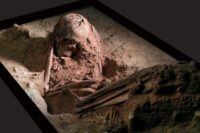A whole grave recovered from the oldest burial ground in Germany has been excavated almost four years after it was removed in a soil block. Radiocarbon analysis of the remains dates the burial ground to approximately 8,000 years ago in the Mesolithic era, just on the cusp of the Neolithic Revolution that saw the arrival of the first farmers in Brandenburg.
 The presence of ancient human burials on a vineyard in the village of Groß-Fredenwalde, northern Brandenburg, was first revealed in 1962 during construction of a radio tower. While some bones were unearthed at that time, there was no systematic archaeological exploration of the site until the 2000s. Subsequent excavations uncovered 12 individual burials, including the oldest infant burial in Germany and one man who had been buried standing up in a vertical pit that was exposed to the elements and animal scavengers for a while before being filled. The graves bear the tell-tale reddish tint from a stone that was typically buried with the dead in Mesolithic Brandenburg. The dozen individuals found there make this burial ground not just the oldest in Germany, but the largest Mesolithic burial ground in the country.
The presence of ancient human burials on a vineyard in the village of Groß-Fredenwalde, northern Brandenburg, was first revealed in 1962 during construction of a radio tower. While some bones were unearthed at that time, there was no systematic archaeological exploration of the site until the 2000s. Subsequent excavations uncovered 12 individual burials, including the oldest infant burial in Germany and one man who had been buried standing up in a vertical pit that was exposed to the elements and animal scavengers for a while before being filled. The graves bear the tell-tale reddish tint from a stone that was typically buried with the dead in Mesolithic Brandenburg. The dozen individuals found there make this burial ground not just the oldest in Germany, but the largest Mesolithic burial ground in the country.
The graves did suffer some damage from the agricultural use of the site, so archaeologists removed the fragile burials en bloc for later examination at the University of Applied Sciences in Berlin. COVID delayed the laboratory excavation, so the last of the soil block burials is only now being revealed.
 This individual was five feet tall and in their early 20s. They were buried in a tight crouching position, legs bent at the knee. The sex has not yet been determined, and osteological examination found no indicators of illness or cause of death. The bones are in excellent condition, giving archaeologists a rare opportunity to deploy the full gamut of analytical technologies on prehistoric human remains, including DNA extraction and strontium isotope analysis. The genetic analysis of other individuals in the burial ground indicates the deceased were natives of Central Europe. They had dark skin and blue eyes. Isotope analysis found they subsisted largely on a diet of fish.
This individual was five feet tall and in their early 20s. They were buried in a tight crouching position, legs bent at the knee. The sex has not yet been determined, and osteological examination found no indicators of illness or cause of death. The bones are in excellent condition, giving archaeologists a rare opportunity to deploy the full gamut of analytical technologies on prehistoric human remains, including DNA extraction and strontium isotope analysis. The genetic analysis of other individuals in the burial ground indicates the deceased were natives of Central Europe. They had dark skin and blue eyes. Isotope analysis found they subsisted largely on a diet of fish.
This burial ground is one of the most important archaeological sites in Germany, not just because of its age, but also because of its location on the boundary between two distinct societies that inhabited Brandenburg in the Mesolithic. The indigenous people of the Uckermark area were hunter-foragers who were born, lived and died there. The first Neolithic farmers, on the other hand, were immigrants who moved to the area from southern Europe. The Groß-Fredenwalde captures this transition in community population and identity from local hunter-foragers to immigrant farmers. Archaeologists hope to reach a new understanding of Mesolithic society and its overlap with the advent of farming by studying the remains in the burial ground — their kinship groups, what they ate, their health, social organization, etc.